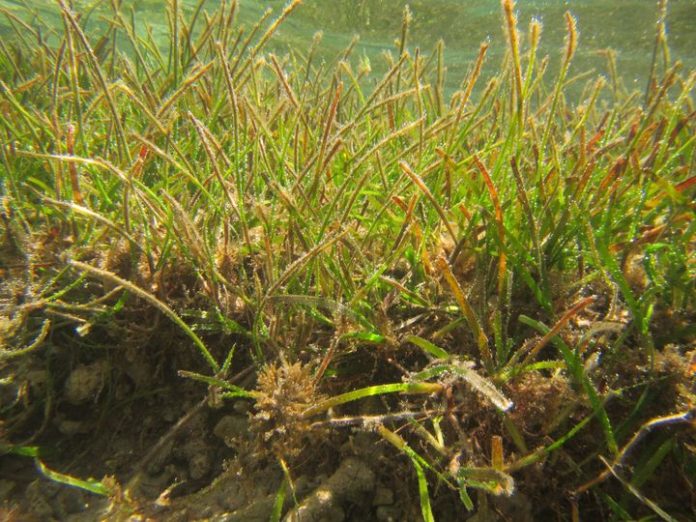In the peaceful water of the Pacific, beneath the gentle sway of the tides lies a hidden world crucial to the health of our oceans: seagrasses.
Dr Shalini Singh, Assistant Professor in Fisheries, College of Agriculture, Fisheries and Forestry at Fiji National University (FNU) sheds light on the often-overlooked wonders of these underwater meadows and their pivotal role in our marine ecosystem.
“Seagrasses” as Dr Singh explains “are a flowering plant, similar to grasses and plants on the land. They are those plants that can have flower, seeds and they have a true plant structure like a separate root system, stem leaves and they are recruited reproductive characteristics.”
“They are able to survive in brackish and seawater environments. So, most of the time, they are submerged in water with the tidal fluctuations.”
Yet, despite their plant complexity, seagrasses are frequently mistaken for algae or seaweed.
With approximately 72 species globally, except for Antarctica, seagrasses play a crucial role in marine ecosystems, although occupying less than 0.2 percent of the ocean floor. “They are important members of the angiosperm group,” Dr Singh said.
The Acting Associate Dean Learning and Teaching explains that seagrasses serve as key habitats and nurseries for various marine species.
“A lot of times if you go out in our Pacific region or coastlines, you will see mangroves and just after the mangroves you will see seagrass.
“Most of the time they will be growing together with seaweeds or algae species and for Fiji and the Pacific, majority of the seagrasses we have would be of a smaller variety which you will find from our located areas like intertidal areas we call them.
“For Fiji, we’ve got a deep-water species which is found so far in our second island, at the Cakaulevu Reef and the seagrass grows up to a depth of around 15 to 20 meters.”
Unlike rainforests, where the majority of carbon is stored above ground, seagrasses store an enormous 90% of their biomass below ground in oxygen-poor sediments, making them efficient carbon sinks for millions of years.
“So over time, even the top seagrass leaves get consumed by some of the fish species, let’s say rabbit fish or turtles, they get damaged, but the below ground root structures are so interconnected to each other, they will remain there for centuries.”

Dr Singh also highlighted that seagrass plays a pivotal role in carbon sequestration, mitigating climate change by capturing and storing atmospheric carbon in their biomass.
“We know that globally, our carbon dioxide emissions have been great even though in the Pacific our emissions of carbon dioxide is not so much but then on the other hand, the Pacific is facing all these climate issues like, sea level rise, storm surges, coastal erosion, all these effects are requiring that we have natural solutions and seagrasses together with mangrove systems, are a natural solution for protecting us or helping us to deal with some of the impacts of climate change.”
However, Dr Singh stressed that seagrasses face numerous threats, that can smother seagrass beds, hindering their ability to photosynthesise and survive.
“Globally, scientists are saying that a lot of sedimentation, when we do development on land, through our rivers and streams ends up in the coastal system where sea grasses and mangrove systems are, and all that sediment gets settled within the mangrove and seagrass areas.
“And if we don’t have mangroves and seagrasses, a lot of the sediment goes over to our coral reef systems and settles on the coral reef and damages.
“The other is lot of nutrients been washed down from the land. Fertilisers where we have a lot of sewage untreated being dumped directly into water bodies and ends up in coastal system. It gives rise to a lot of algae.
“So, both the nutrients and sediments what they do, the sediments will cover up the water body. Seagrasses need to have photosynthesis so they need clear water, but the waters remained dirty or muddy over a long period of time which will prevent seagrasses from photosynthesising and the plants will die.
“The other is when a lot of nutrients starts to be found in water then you have a lot of this plant like animals, we call them phytoplankton. So, all these microscopic animals will be increasing in numbers, and they will also prevent sunlight from penetrating the seagrasses.”
She emphasised the urgent need for conservation efforts, also observing that local communities often possess time-honored practices that inadvertently protect seagrass habitats.
In Fiji, where Dr Singh conducts much of her research, seagrasses are integral to coastal communities’ livelihoods and cultural practices.
“A lot of these Qoliqoli owners (coastal community landowners), had, or they have effectively placed in temporary or permanent areas which are prohibited for fishing and harvesting of marine based organisms.
“So knowingly or unknowingly, most of them probably without the knowledge that they are also protecting seagrass areas. In that way, they were a step ahead than most of the scientific communities.
“All we have done is go in and provide them that additional information regarding why seagrasses are important and its role.
“Communities themselves have come forward and told us that they have been seeing more varieties of marine offshore species like sea turtles in the coastal systems and fish species like barracudas.”
Dr Singh emphasises the importance of integrating traditional wisdom with contemporary conservation approaches to ensure effective management of local seagrass resources.
“So, I think local traditional communities already know that their traditional methods of protecting is workable, it’s just that scientific information is what we provide to them to understand why and what and how that is needed.”
With organisations and local communities, Dr Singh is leading initiatives to raise awareness, monitor seagrass health, and restore degraded habitats. Through community engagement and scientific research, she hopes to inspire future generations of researchers and conservationists to safeguard our precious marine ecosystems.














